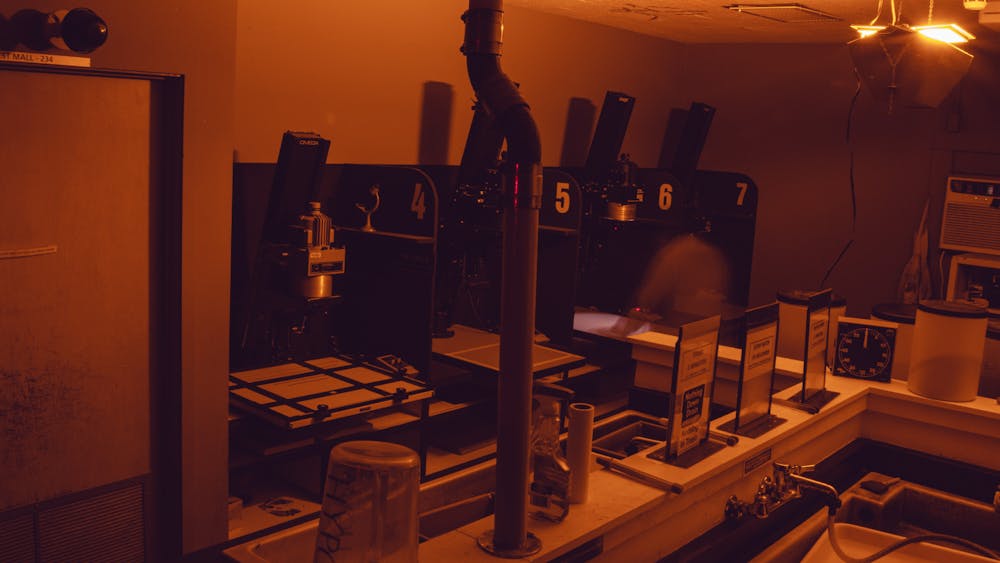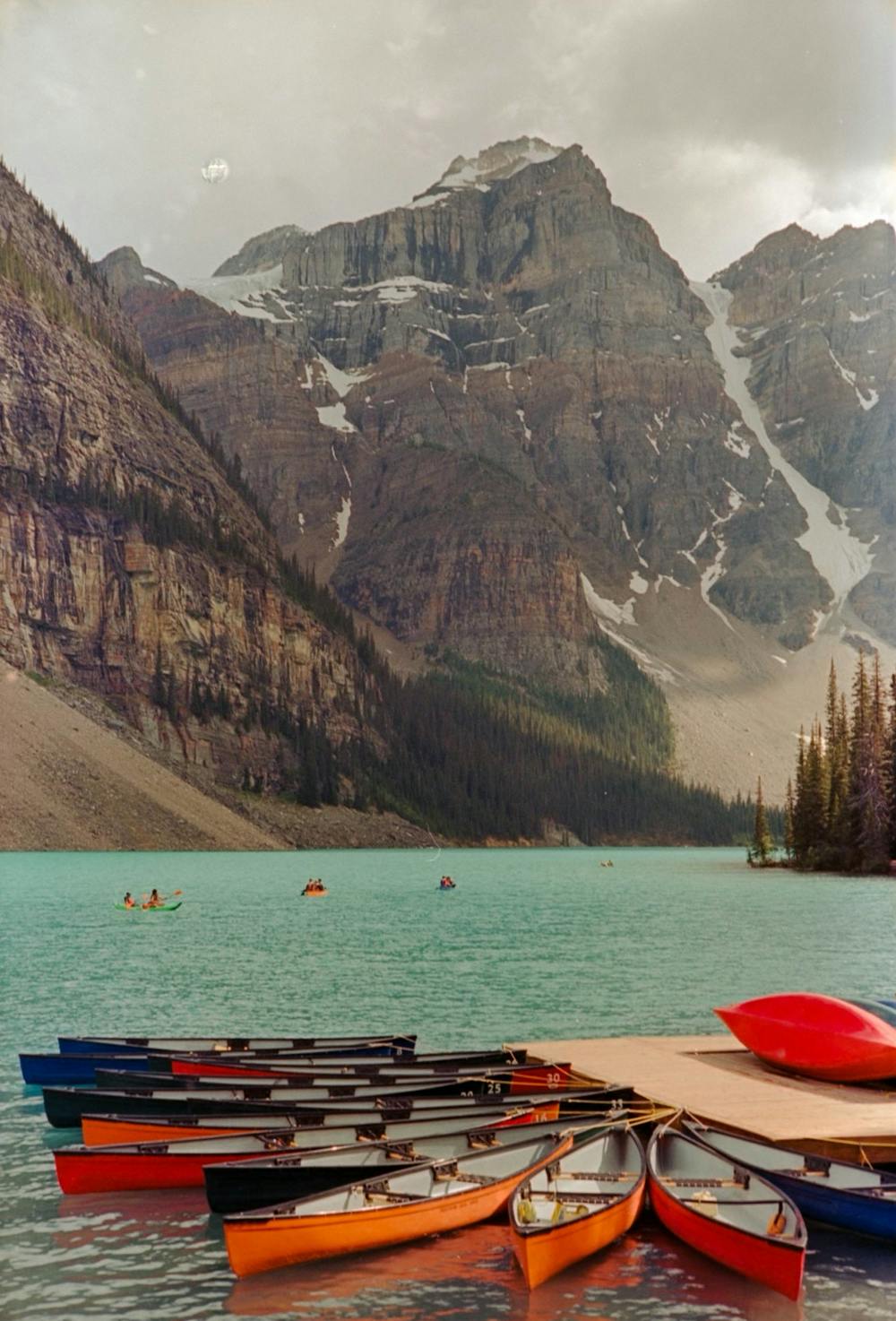When Aidan Ruiz decided to buy a film camera on a whim, he didn't expect the used Nikon with a broken autofocus would ignite a passion for photography. After acquiring the camera in a meeting with the seller, the senior studying finance threw in a 36-photo roll and proceeded to shoot all of it on campus.
What he captured could be described only as "horrendous," Ruiz said.
But he was hooked. Though Ruiz had taken photos with a digital camera before, his infatuation with film's nostalgic grain and raw quality inspired him to experiment with different formats, lenses and subjects. Since then, he's added another film camera to his collection — a 65-year-old Mamiya RB67 — but his vintage Nikon remains a favorite.
"I still own that camera today," Ruiz said. "I still shoot with it every weekend."
Even though today's generation lives in a digital world where iPhones can capture videos in 4K Cinematic mode with just the tap of a finger and cutting-edge cameras can operate at 120 frames per second, many are still running to eBay and thrift stores in search of old film cameras.
"Film just hits different," Ruiz said.
'A very expensive hobby'
"The entire process of having to slow down when you take photos — because you know film is expensive and you have 36 shots per roll — is an entirely different experience than taking (photos) on a digital camera," Ruiz said.
Ruiz puts his film camera skills to work as a part-time automotive photographer, for which he attends car events or photo shoots throughout Arizona every week. As a result, Ruiz estimates that he goes to a store to develop film at least once a week.
Despite its popularity among younger photographers, film photography comes at a cost. Along with the price of purchasing a film camera, Ruiz said he pays roughly $4 to develop film every time he clicks the shutter button.
"The cost is definitely coming out of my own pocket," Ruiz said. "I'm very fortunate that I do have a job that pays relatively well for a college student. It allows me to at least scratch this itch of photography that I have every once in a while."
Isabella McDonald, a junior studying criminology and criminal justice, fell in love with film photography back in high school after shooting with disposable film cameras.
"I was looking at eBay all the time to see if I could find a vintage camera for cheap," she said.
She ended up ordering an Olympus Infinity Stylus, a camera that sells on eBay for anywhere from $55 to over $170. When the pricey camera arrived, however, it was broken, forcing McDonald to go on the hunt for a new film camera.
Instead of trusting another reseller, McDonald received an old film camera from a coworker who no longer used it.
"It was an old Yashica Japanese vintage camera," she said. "I've been shooting with that one ever since."
Even though McDonald used to go through rolls of film more frequently, she has since slowed down due to the high cost of developing film.
"Any time I would go on vacation or somewhere out of my usual routine, I would bring it along," McDonald said. "But it’s a very expensive hobby."
While there are cheaper alternatives to film photography that can still capture its unique aesthetic — such as apps like Huji Cam — McDonald believes using tools on smartphones to capture film photography-like images defeats the entire purpose of film.
"I do not like those apps at all," McDonald said. "If you want something that looks like a film photo, just go buy a $15 disposable camera and get that developed. It makes the whole ritual so much more exciting because you have to wait to get your results back."
The darkroom
As photography becomes more digitized, places that specialize in rapid film development have become few and far between, according to Bloomberg. In 1993, a year before Apple launched the first color digital camera that cost less than $1,000, the number of active one- hour photo stores peaked at 7,600. Just 20 years later, in 2013, only 190 shops remained throughout the country.
Although dropping off rolls at local drugstores remains a popular option for film photography enthusiasts, many have complained these places are often unreliable, preferring to develop their photos themselves.
Ava Hanson, a junior studying biochemistry, has developed film from start to finish many times in her friend's darkroom.
"Buying the film, shooting the film, developing the film and making the prints — the whole process is what makes film so special," Hanson said.
Developing film is a multipart process that requires darkness, various chemicals and water, according to B&H Photo Video.
The first step in the process involves soaking the film in developer, a combination of chemicals that activate the compounds in the film that were exposed to light when the photo was taken.
Water is then used to rinse off the chemicals, stopping development so the compounds do not become overdeveloped. The film then undergoes a "fixing" process in which it’s exposed to chemicals that will make the image appear clearly on the film.
The fixer is then washed off, and the film is hung to dry, ready for photographers to print its images onto photo paper.
Despite knowing the development process inside and out, Hanson admitted that sometimes, she'd rather send her photos away to get professionally developed to ensure they come out perfectly.
"It depends on what you're shooting," Hanson said. "There are certain shoots I've done that I know what’s on (the rolls), and I don't want them to get messed up. I'd rather just send it somewhere and not deal with the stress.”
While the darkroom process requires time, patience and a number of tools, Hanson said the DIY aspect of the development experience is a useful skill that's worth knowing for film photographers, even if it's not their go-to development technique.
"Developing your own (film) is special in its own way," she said. "Scanning (photos) one by one and holding them up to the light is super fun, but if you're a photographer and you strictly drop off your film, I have no hate toward that at all."
Resisting digital
As avid film photographers, both McDonald and Ruiz are members of the Film Photography Club at ASU. The club's Instagram account is flooded with over a hundred multicolored and grayscale photos spattered with vintage grain and washes of light, which were captured by students who partake in the old practice.
McDonald said she prefers film photography over digital photographs because it captures the fleeting feeling of nostalgia.
"That's what the first photos were made from," McDonald said. "Every old picture you see has that grainy texture, and the colors are so vibrant."
Ruiz said shooting with film has granted him the expertise that someone using a digital camera might not have, giving him an edge in the highly competitive world of automotive photography.
"Film photography is the rawest form of photography," Ruiz said. "I think the way that you really learn how a sensor on a digital camera works is by starting with film.
“(You have to know) how the predecessor to your digital camera works in the first place."
Ruiz said anyone can pick up a film camera and begin working with film photography, joking that he learned film techniques online at "YouTube university." However, the learning never stops.
"I've been shooting photos for three years at this point, and there's stuff I couldn’t even begin to tell you how to do," Ruiz said.
Edited by Camila Pedrosa, Savannah Dagupion and Madeline Nguyen.
This story is part of The Development Issue, which was released on April 3, 2024. See the entire publication here.
Reach the reporter at lmesqui2@asu.edu and follow @leahmesquitaa on X.
Like State Press Magazine on Facebook, follow @statepressmag on Twitter and Instagram and read our releases on Issuu.







